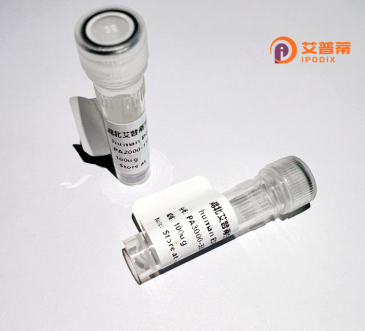
| 纯度 | >90%SDS-PAGE. |
| 种属 | Human |
| 靶点 | TESPA1 |
| Uniprot No | A2RU30 |
| 内毒素 | < 0.01EU/μg |
| 表达宿主 | E.coli |
| 表达区间 | 1-394 aa |
| 活性数据 | MTGGTNKTSSSISEILDKVQEDAEDVLFSLGFGQEDHKDTSRIPARFFTTPSQAKGIDFQLFLKSQVRRIEMEDPCLMLASRFKQVQTLAVTADAFFCLYSYVSKTPVQKFTPSHMFWNCNHPTDVPSIRILSREPEPQSPRDRLRKAISKMCLYTCPRDRPPPPHNTPKRNSLDQVVLEVMDKVKEEKQFLQQDSDLGQFSQEDPVPPAEGKKLPTSPYPCVFCCEEETQQRMSTVLAPSQTLDSNPKVPCCTHSLPIEDPQWSTDPAQIRRELCSLPATNTETHPAKDETFWKRKSRARKSLFQKNLMGRKVKSLDLSITQQKWKQSVDRPELRQSLSQQPQDTFDLEEVQSNSEEEQSQSRWPSRPRHPHHHQTFAGKFVKLSPPPQQHVV |
| 分子量 | 71.6 kDa |
| 蛋白标签 | GST-tag at N-terminal |
| 缓冲液 | PBS, pH7.4, containing 0.01% SKL, 1mM DTT, 5% Trehalose and Proclin300. |
| 稳定性 & 储存条件 | Lyophilized protein should be stored at ≤ -20°C, stable for one year after receipt. Reconstituted protein solution can be stored at 2-8°C for 2-7 days. Aliquots of reconstituted samples are stable at ≤ -20°C for 3 months. |
| 复溶 | Always centrifuge tubes before opening.Do not mix by vortex or pipetting. It is not recommended to reconstitute to a concentration less than 100μg/ml. Dissolve the lyophilized protein in distilled water. Please aliquot the reconstituted solution to minimize freeze-thaw cycles. |
以下是关于TESPA1蛋白的3篇关键参考文献的简要信息:
1. **文献名称**:*TESPA1 regulates TCR-induced calcium influx by linking inositol-1.4.5-trisphosphate receptors to TCR complex*
**作者**:Wang H. et al. (2015)
**摘要**:该研究揭示TESPA1通过连接T细胞受体(TCR)信号复合物与内质网上的IP3受体,调控TCR激活后的钙离子内流,影响T细胞发育和免疫应答。
2. **文献名称**:*Thymocyte-expressed, positive selection-associated coreceptor differentially regulates T cell immunity*
**作者**:Zhu M. et al. (2012)
**摘要**:首次报道TESPA1在T细胞阳性选择中的核心作用,发现其缺失导致胸腺细胞成熟障碍和T细胞介导的自身免疫反应减弱,提示其在免疫耐受中的功能。
3. **文献名称**:*TESPA1 coordinates with Lck to amplify TCR signaling in thymocyte development*
**作者**:Yao Y. et al. (2017)
**摘要**:证明TESPA1通过与激酶Lck相互作用增强TCR信号传导,调控双阳性胸腺细胞的存活与分化,揭示其作为信号转导枢纽的分子机制。
**备注**:TESPA1研究多集中于T细胞信号传导领域,以上论文均发表于《Immunity》《J Biol Chem》等免疫学/生化权威期刊,可作为该蛋白功能研究的核心文献基础。
TESPA1 (Thymocyte-expressed positive selection-associated protein 1) is a transmembrane protein predominantly expressed in thymocytes and T cells. It plays a critical role in T-cell development and immune regulation, particularly during positive selection in the thymus—a process ensuring mature T cells recognize self-MHC molecules without excessive reactivity to self-antigens. TESPA1 interacts with components of the T-cell receptor (TCR) signaling pathway, including Lck and ZAP-70 kinases, facilitating signal transduction required for thymocyte survival and differentiation. Structurally, it contains an N-terminal intracellular domain, a transmembrane region, and a C-terminal extracellular domain with potential phosphorylation sites and protein-binding motifs.
Studies using knockout mouse models revealed that TESPA1 deficiency impairs TCR signaling, leading to reduced thymocyte proliferation, altered CD4+/CD8+ T-cell ratios, and compromised immune responses. This highlights its regulatory role in maintaining T-cell repertoire diversity and tolerance. Recombinant TESPA1 protein, typically produced in *E. coli* or mammalian expression systems, retains functional epitopes and is used to study protein-protein interactions, signaling mechanisms, and immune modulation *in vitro*. Its applications extend to exploring therapeutic targets for autoimmune diseases, immunodeficiency disorders, and optimizing T-cell-based immunotherapies. Recent research also suggests potential links to cancer progression via immune microenvironment regulation.
×